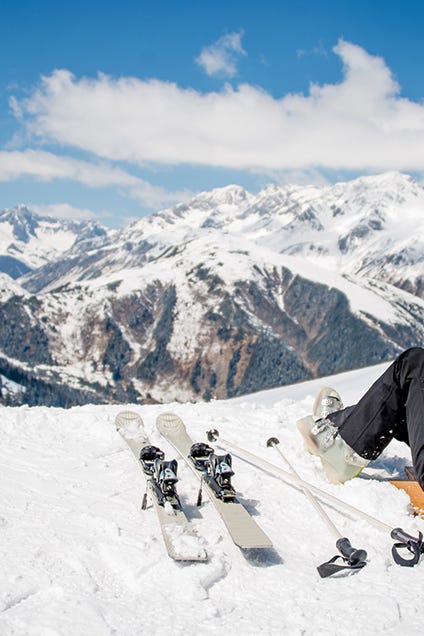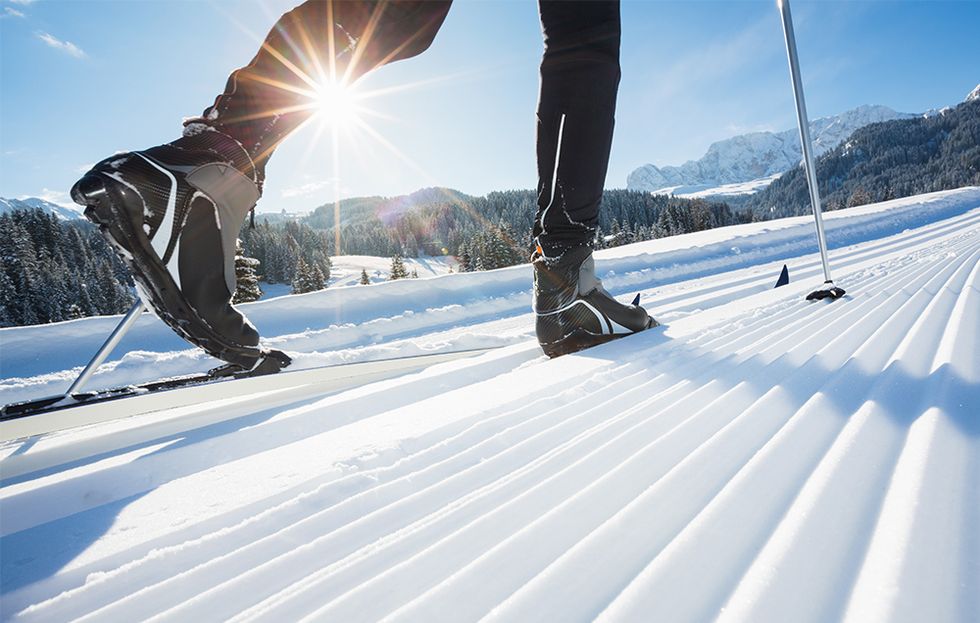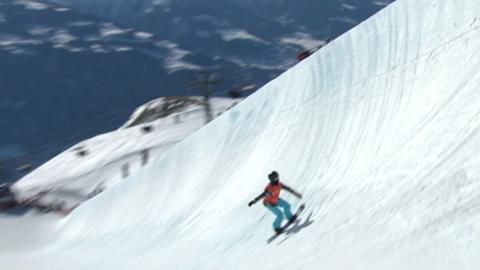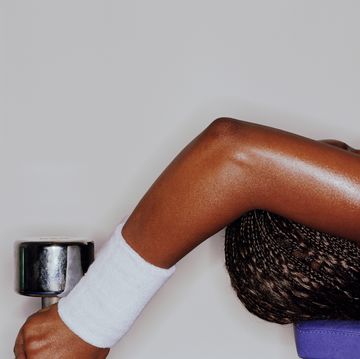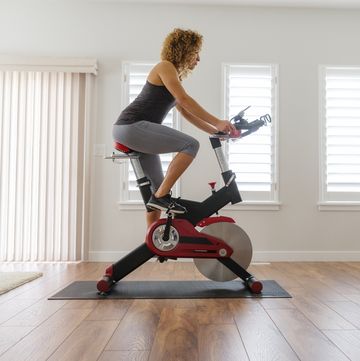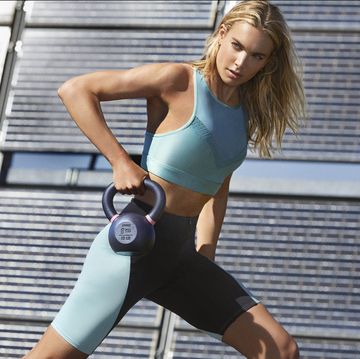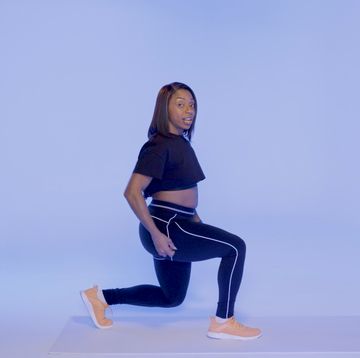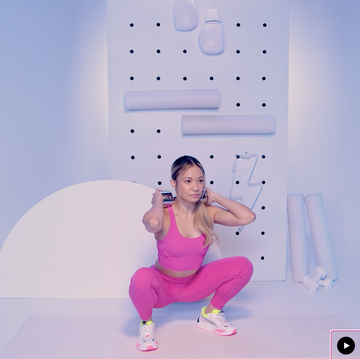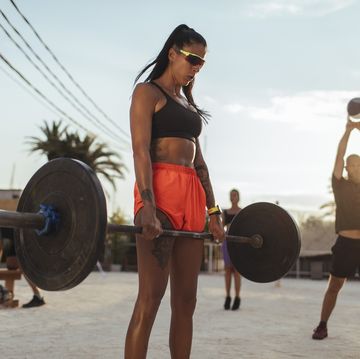Love the feel of fresh air hitting your lungs as you break a sweat beneath the sun or stars? We don't blame you. Spending time in nature is every bit as enjoyable as the hit of endorphins you get from revving your heart rate on a jog or hike.
So let's be clear: Just because it’s winter (and there might even be some snow on the ground), that doesn’t mean you need to give up your outdoor fitness routine.
As long as you have the correct gear, you can still continue to get your sweat on outside—you may just have to change up what you’re doing. Before you settle in for a long winter of boring treadmill runs, consider trading your go-to outdoor workouts for these winter activities that burn mega calories and rev your heart rate just as much as your usual warm-weather routines.
Cross-Country Skiing
At a high intensity, this activity tops the charts when it comes to calorie burn. If you’re in good shape and well versed in the sport, you can burn up to 20 calories per minute—which is over 1,000 calories an hour, explains Wayne Westcott, Ph.D., C.S.C.S., professor of exercise science at Quincy College in Quincy, MA. “Cross-country skiing recruits your legs, quads, glutes, and because you’re pushing off the ground with each step, you’re using the abductors on your outer thighs, too, which you wouldn’t work running or riding a bike,” he says. “And you’re working even more musculature including your shoulders, triceps, biceps, and upper back by using the poles to help you propel forward.”
You can’t forget the core muscles, too. The one-pole-with-opposite-leg movement forces a constant twisting motion, working the obliques. Cross-country skiers are the athletes with the highest VO2 max (a.k.a. your peak oxygen intake, or how well your body delivers oxygen to your cells), says Westcott. "Even higher than marathon runners."
Related: This Is the Best Exercise to Work ALL Those Core Muscles
Uphill Skiing or Skinning
This vigorous outdoor activity falls in right behind cross-country skiing, burning about 18 calories per minute, says Westcott. “That’s the equivalent calorie burn of running a five-minute mile,” he says. “And that’s just one mile—you’re doing a lot more work on skis.” When skinning, expect to fire up the hamstrings, glutes, and quads with each step, and the triceps, upper arms, shoulders, and upper back when using the poles. “You also have to maintain your posture, so your core and lower back will be working, too,” says Westcott.
See how professional snowboarder Kelly Clark manages her fear:
Ice Skating
You can’t deny it—ice skaters have insanely great glutes. And that’s because they have to: “When you ice skate, your power comes from glutes,” says Noam Tamir, C.S.C.S., founder of TS Fitness in New York City. “Each time you push off one foot, you go into hip extension and the glutes are the main driver there." He says you also work the adductors and abductors in your legs, "which are very important during the propulsion of the movement, as your legs move away from and then return to the center of your body.”
Posture is crucial when skating as well. In order to maintain an upright position, you need to work your core and use your obliques and the muscles in your lower back for rotation. “Since your nervous system is required to keep you stable, you’re are definitely using it, and you'll keep burning calories as long as your intensity is high,” says Tamir. He also notes that you can burn up to 15 calories per minute with this seemingly effortless exercise.
Related: 3 Workouts That Burn More Calories Than A 3-Mile Run
Snowshoeing
Watch out hip flexors, this winter sport is for you. With each step you take snowshoeing, you’ll be working against the resistance from the snow to pull your foot up, working not only your hip flexors, but also your iliacus and psoas muscles in the hip, explains Westcott. “Because snowshoes are wider than normal shoes, your stance will naturally be a bit wider, so you’ll also be firing up your thighs a lot,” he says. “This is particularly a lower-body exercise that works the hips, glutes, hamstrings, and quads.” And even though you’re walking, snowshoeing burns a lot more, clocking in at about 500-plus calories per hour, depending on intensity.
Want the world’s best fitness plans for FREE? Then check out Salty Cat Workouts now! (And no, we don’t give a %$!# what you think about the name.)
Snowboarding
Since you’re not holding poles here, the only work you’re doing with your arms while snowboarding is holding them out to the sides. But it’s still possible to burn upwards of 400 calories per hour shredding the gnar. Snowboarding mainly works the lower body and core muscles. “Since shifting of weight is important with this sport, your core—especially the obliques—are used to rotate the torso and stabilize the lower body,” explains Tamir. “You’ll also be using your feet, glutes and hips in order to turn and cut to make your line down the mountain.”
Skiing
It only takes one look at Lindsey Vonn to know skiers need to have strong legs. Skiing depends on your inner thighs, hips, and outer thighs to help move your skis the direction you want to go. And because you have bent your knees when you’re on skis, this isometric position will keep your quads constantly activated, explains Tamir. All of this work can burn up to 300 calories per hour, according to Mayo Clinic. But that’s not all! “Feet are important and always moving when you’re skiing, but they get a lot of direction from the muscles in your shins and calves,” explains Wescott. “And with each 180 degree turn down the mountain, you’ll get tremendous work through your obliques and torso.”
Related: If You Hate Running, This Is The Perfect Fat-Burning Cardio Workout For You
Snow-ga
We’re not saying it’s the best idea to go out and do yoga in the freezing-cold weather, but it does make for a great Instagram photo! And if you’re dressed appropriately, why not? Plus, it actually may be beneficial to do yoga in the cold when it comes to calorie burn, explains Westcott. “The activity that burns the most calories passively is shivering. So you’d be burning extra calories just to keep warm, plus your body isn’t losing water sweating, so it actually makes sense.” A normal hatha yoga class burns around 180 calories per hour, according to Mayo Clinic, so you’d be adding to that in the cold temperature. Depending on how intense a flow you’re doing, you’ll be working your entire body including the legs, core, and arms, back, and shoulders.

Amy Schlinger is a health and fitness writer and editor based in New York City whose work has appeared in Men’s Health, Women’s Health, The New York Post, Self, Shape, Cosmopolitan, Glamour, and more; The National Academy for Sports Medicine Certified Personal Trainer (NASM-CPT) is extremely passionate about healthy living and can often be found strength training at the gym when she isn’t interviewing trainers, doctors, medical professionals, nutritionists, or pro athletes for stories.
